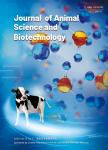Postpartum meloxicam administration alters plasma haptoglobin, polyunsaturated fatty acid, and oxylipid concentrations in postpartum ewes
Postpartum meloxicam administration alters plasma haptoglobin, polyunsaturated fatty acid, and oxylipid concentrations in postpartum ewes作者机构:Department of Animal Sciences and IndustryKansas State UniversityManhattan 66506USA College of Veterinary MedicineMichigan State University2265K Anthony HallEast LansingMI 48824-1225USA Department of Animal ScienceIowa State UniversityAmesIAUSA.
出 版 物:《Journal of Animal Science and Biotechnology》 (畜牧与生物技术杂志(英文版))
年 卷 期:2020年第11卷第4期
页 面:1047-1060页
核心收录:
学科分类:0710[理学-生物学] 0831[工学-生物医学工程(可授工学、理学、医学学位)] 0832[工学-食品科学与工程(可授工学、农学学位)] 090502[农学-动物营养与饲料科学] 1004[医学-公共卫生与预防医学(可授医学、理学学位)] 0905[农学-畜牧学] 09[农学] 0906[农学-兽医学] 0703[理学-化学] 0836[工学-生物工程]
基 金:funded by a Let’s Grow grant through the American Sheep Industry。
主 题:Eicosanoid Inflammation Lactation Nonsteroidal anti-inflammatory drug Sheep
摘 要:Background: Postpartum inflammation is a natural and necessary response;however, a dysfunctional inflammatory response can be detrimental to animal productivity. The objective of this study was to determine the effects of a non-steroidal anti-inflammatory drug(meloxicam) on ewe postpartum inflammatory response, ewe plasma polyunsaturated fatty acid and oxylipid concentrations, and lamb growth.Results: After lambing, 36 Hampshire and Hampshire × Suffolk ewes were sequentially assigned within type of birth to control(n = 17) or meloxicam orally administered on d 1 and 4 of lactation(MEL;90 mg, n = 19). Milk and blood samples were collected on d 1(prior to treatment) and d 4. Milk glucose-6-phosphate was not affected by MEL. Plasma haptoglobin(Hp) concentrations were less for MEL ewes;control ewes with greater d 1 Hp concentrations had elevated Hp on d 4, but this was not the case for MEL-treated ewes. Treatment with MEL increased plasma arachidonic acid concentration by more than 4-fold in ewes rearing singles but decreased concentrations of 9,10-dihydroxyoctadecenoic acid, prostaglandin F2α, 8-iso-prostaglandin E2, and 8,9-dihydroxyeicosatetraenoic acid. Nine oxylipids in plasma had interactions of treatment with d 1 Hp concentration,all of which revealed positive associations between d 1 Hp and d 4 oxylipid concentrations for CON, but neutral or negative relationships for MEL. MEL decreased 13-hydroxyoctadecadienoic acid:13-oxooctadecadienoic acid ratio and tended to increase 9-hydroxyoctadecadienoic acid:9-oxooctadecadienoic acid ratio(both dependent on d 1 values), indicating progressive metabolism of linoleic acid-derived oxylipids occurred by enzymatic oxidation after MEL treatment. Meloxicam reduced oxylipids generated across oxygenation pathways, potentially due to an improved redox state.Conclusions: Postpartum MEL treatment of ewes decreased plasma concentrations of Hp and several oxylipids,with the greatest impact in ewes with biomarkers reflecting a greater inflammatory state before treatment. Antiinflammatory strategies may help resolve excessive postpartum inflammation in some dams.



